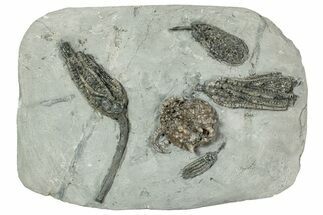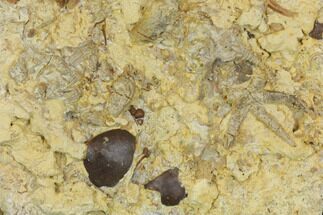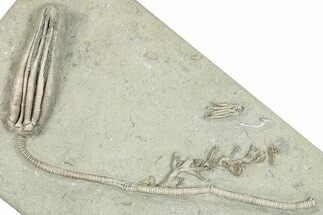This Specimen has been sold.
Spectacular 16" Fossil Crinoid Plate - Crawfordsville, Indiana
This is a superb, one of a kind crinoid, holdfast, and starfish association plate collected from the Edwardsville Formation of Crawfordsville, Indiana. The crinoids include: Cyathocrinites multibrachiatus (#17), Histocrinus sp. (#29), a huge Actinocrinites gibsoni crinoid (#52), Camptocrinus sp. (#57), three Macrocrinus mundulus crinoids (#69), Eretmocrinus granuliferus (#77), two unidentified crinoids (#97), and an incredible Cyathocrinites nodosus (#100) crinoid with no crushing of the calyx. The plate also includes multiple crinoid holdfasts and a starfish (#91) wrapped around the crown of Eretmocrinus granuliferus.
This is a natural association with natural stems, few repairs, and minimal restoration, truly a museum quality specimen. The preparation on these fossils is exquisite - using skillful air-abrasion techniques under a stereo microscope.
#17 - Cyathocrinites multibrachiatus (5.5" long including stem)
#29 - Histocrinus sp. (5" long including stem)
#52 - Actinocrinites gibsoni (6.5" long including stem)
#57 - Camptocrinus sp. (.5" wide)
#69 - Macrocrinus mundulus (1.3", 1.9", and 2.2" long including stems)
#77 - Eretmocrinus granuliferus (1.95" long)
#91 - Unidentified Starfish (1.7" wide)
#97 - Unidentified Crinoids (.8" and 2.2" long including stems)
#100 - Cyathocrinites nodosus (4.3" long including stem)
Just to the right of Cyathocrinites multibrachiatus (#17) and just below Actinocrinites gibsoni (#52) is what appears to be either another crinoid or a holdfast. Without a calyx visible, it's difficult to accurately identify, though its arms are similar in structure to Barycrinus.
This is a natural association with natural stems, few repairs, and minimal restoration, truly a museum quality specimen. The preparation on these fossils is exquisite - using skillful air-abrasion techniques under a stereo microscope.
#17 - Cyathocrinites multibrachiatus (5.5" long including stem)
#29 - Histocrinus sp. (5" long including stem)
#52 - Actinocrinites gibsoni (6.5" long including stem)
#57 - Camptocrinus sp. (.5" wide)
#69 - Macrocrinus mundulus (1.3", 1.9", and 2.2" long including stems)
#77 - Eretmocrinus granuliferus (1.95" long)
#91 - Unidentified Starfish (1.7" wide)
#97 - Unidentified Crinoids (.8" and 2.2" long including stems)
#100 - Cyathocrinites nodosus (4.3" long including stem)
Just to the right of Cyathocrinites multibrachiatus (#17) and just below Actinocrinites gibsoni (#52) is what appears to be either another crinoid or a holdfast. Without a calyx visible, it's difficult to accurately identify, though its arms are similar in structure to Barycrinus.
Crinoids from the Ramp Creek Limestone were likely buried in sediment from nearby deltas during storms. The resulting siltstone deposits are soft enough that fossils can be extracted in exquisite, three-dimensional relief.
Crinoids, sometimes commonly referred to as sea lilies, are animals, not plants. They are echinoderms related to starfish, sea urchins, and brittle stars. Many crinoid traits are like other members of their phylum. Such traits include tube feet, radial symmetry, a water vascular system, and appendages in multiples of five (pentameral). They first appeared in the Ordovician (488 million years ago) and some species are still alive today.
Crinoids, sometimes commonly referred to as sea lilies, are animals, not plants. They are echinoderms related to starfish, sea urchins, and brittle stars. Many crinoid traits are like other members of their phylum. Such traits include tube feet, radial symmetry, a water vascular system, and appendages in multiples of five (pentameral). They first appeared in the Ordovician (488 million years ago) and some species are still alive today.
SPECIES
Various
LOCATION
Crawfordsville, Indiana
FORMATION
Edwardsville Formation
SIZE
Rock: 16 x 6.7"
CATEGORY
SUB CATEGORY
ITEM
#255133
We guarantee the authenticity of all of our specimens.
 Reviews
Reviews

















